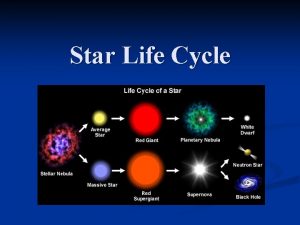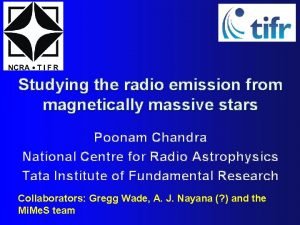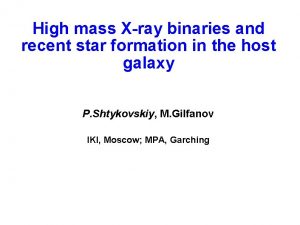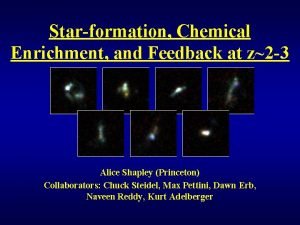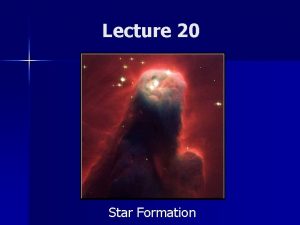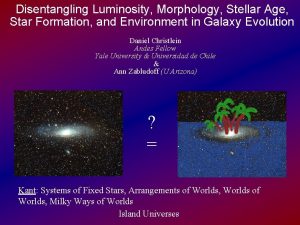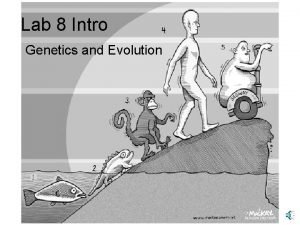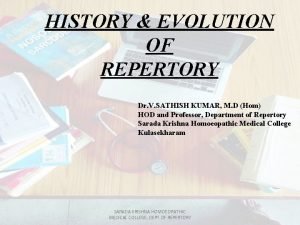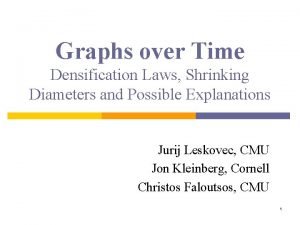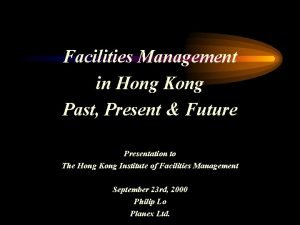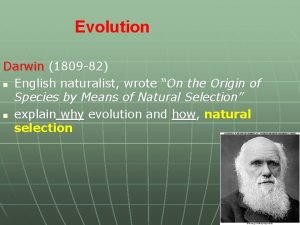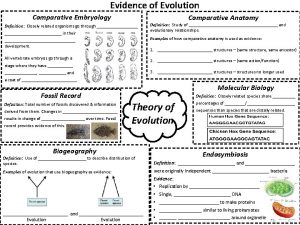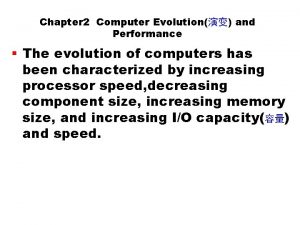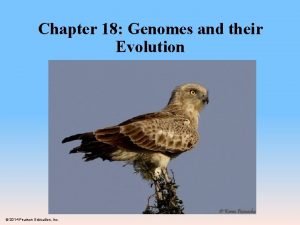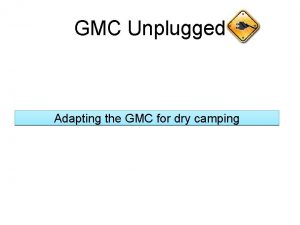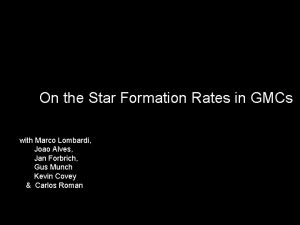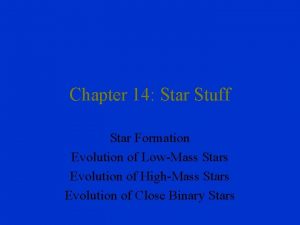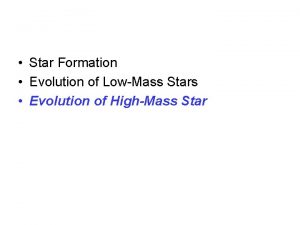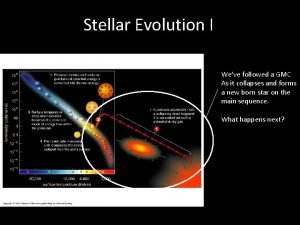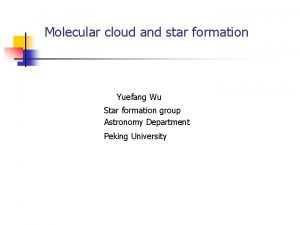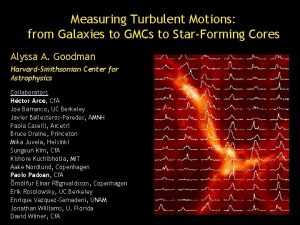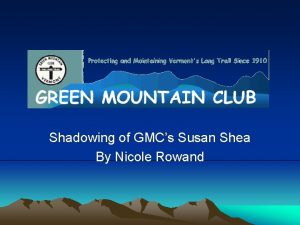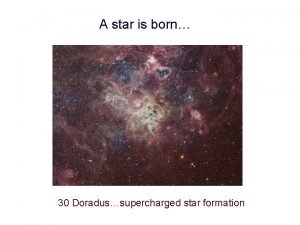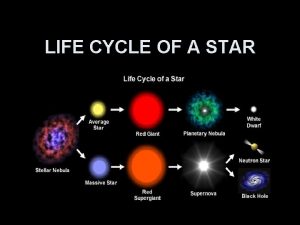GMC Evolution of GMCs and star formation in

































- Slides: 33

渦状銀河におけるGMCの進化と星形成 Evolution of GMCs and star formation in spiral galaxies 1. NRO M 33 All-Disk Survey of Giant Molecular Clouds (NRO MAGi. C) 2. Preliminary results of ALMA cycle 0 observations of M 83 3. CO Galactic Plane Survey by NRO 45 -m telescope Nario Kuno Nobeyama Radio Observatory

Collaborators T. Tosaki 1, S. Onodera 2, R. Miura 3, K. Muraoka 5, S. Komugi 3, T. Sawada 3, K. Nakanishi 3, K. Kohno 4, H. Kaneko 6, A. Hirota 7, N. Arimoto 7, H. Nakanisi 8, R. Kawabe 3, F. Egusa 9, K. Wada 8 1 Joetsu University of Education 2 Meisei university 3 Chile observatory, NAOJ 4 University of Tokyo 5 Osaka Prefecture University 6 Tsukuba university, 7 NAOJ 8 Kagoshima University 9 ISAS

Introduction • Cycle of matter in galaxies – Evolution of molecular clouds (from atomic gas to dense gas) are one of the main themes of radio astronomy

Observations of GMCs in nearby galaxies – – – LMC: Kawamura et al. 2009, Hughes et al. 2010… M 33: Rosolowsky et al. 2007, Gratier et al. 2012… M 51: Koda et al. 2011, Egusa et al. 2011… IC 10: Leroy et al. 2006 M 31: Rosolowsky et al. 2007 Scientific objectives: • Basic properties of GMCs (mass, size, …) • Evolution of ISM ⇔ star formation process – GMC formation → dense gas → stars → destruction of GMCs in M 33 and M 83

1. NRO M 33 All-Disk Survey of Giant Molecular Clouds (NRO MAGi. C) n Close to our Galaxy (D = 840 kpc) each GMC can be resolved (NRO 45 m resolution: 20"~ 80 pc) n. Many star-forming regions over the whole disk n Moderately face-on GMCs are distributed throughout the disk and are in relation to other components (e. g. star-forming regions, arms, …) The best target for studying GMCs and star formation within a whole galaxy (Arimoto et al. )

• Data – Molecular gas : 12 CO(1 -0) (45 m) – Warm and dense molecular gas : 12 CO(3 -2)(ASTE) : 13 CO(1 -0) (45 m) – Cold dust : 1. 1 mm (ASTE:Az. TEC) – Star-forming region : Ha(SUBARU) – Stars : B, V, R, I (SUBARU) – Atomic gas, IR … : (Archived data) Properties and evolution of GMCs

High resolution & wide field mapping w/ NRO 45 m/ASTE 10 m + OTF • HPBW=16” @ CO(1 -0) • 25 beams! + OTF • HPBW=22” @ CO(3 -2) • Tsys~150 K! + OTF NRO 45 m uniform Atacama Submillimeter Highly quality Telescope Experiment Array receivers “ 25 BEARS” “CATS 345”

12 CO(1 -0) map with NRO 45 m with 45 m 1 kpc Many GMCs are identified Velocity field Globally galactic rotation Tosaki et al. 2011

Color : 12 CO(3 -2) with ASTE Grey & contour : 12 CO(1 -0) with NRO 45 m 4. 2× 4. 2 5× 5 2. 5× 3 3. 3× 3. 3 4. 4× 4 2. 5× 2. 5 5. 2× 5. 6 7. 3× 3. 3 ΔTmb ~ 13 -20 mk Total ~ 140 arcmin 2 Wide range of CO(3 -2)/CO(1 -0) Miura et al. 2012

1. 1 mm map Komugi et al. 2011

1. 1 Formation of molecular clouds 1. 2 Relation between molecular gas and star formation 1. 3 Evolution of Giant Molecular Clouds 1. 4 Radial gradient of dust temperature

1. 1 Formation of molecular clouds – Molecular gas is formed more efficiently in inner region than outer region (Tosaki et al. 2011) CO+HI CO+SFR

Correlation between gas surface density and fmol Σgas Two distinct sequences on the Σgas – fmol

Molecular gas fraction; fmol Function of 1. metallicity Z 2. radiation field U 3. gas pressure (or gas volume density n) (Elmegreen 1993) high Z/high n ⇒ efficient H 2 formation high U⇒ efficient H 2 destruction

• Sharp increase of metallicity in the central region from ~2 kpc • Model calculations are consistent with the observed results quantitatively 2 kpc Vilchez et al. 1988

1. 2 Relation between molecular gas and star formation Kennicutt-Schmidt law • global correlation between surface density of gas and star formation rate M 51 To what scale is the Kennicutt-Schmidt law valid? 0. 5 -2 kpc scale (Kennicutt et al. 2007)

• Breakdown of the Kennicutt-Schmidt law at high resolution (~ 80 pc) Σ(SFR)Hα, corr [Moyr-1 pc-2] Resolution ~80 pc ~250 pc Check by changing spatial resolution from 1 kpc to 80 pc l Becomes looser with higher spatial resolution ~500 pc ~1 kpc 2σ ⇒The Kennicutt-Schmidt law becomes invalid in GMC scale (~80 pc) Difference of evolutionary stage of GMCs Σ(H 2)[Mo pc-2] (Onodera et al. 2010)

Correlation between CO(3 -2) and SFR => CO(3 -2) traces denser and warmer gas SFR vs. CO(1 -0) intensity SFR vs. CO(3 -2) intensity (Onodera et al. 2012 PASJ in press)

1. 3 Evolution of Giant Molecular Clouds – Variation of star-forming activity in molecular clouds (Miura et al. 2012) CO(3 -2) + young stars CO(1 -0) + young stars 71 GMCs • Ha, 24 um => HII regions • Stellar groups Optical data => age of stars CO(3 -2)/CO(1 -0) Ha + young stars Type C: With HII regions With young stellar groups (< 10 Myr)

Classification of GMCs: 4 types of GMCs Type A: No HII regions No young stellar groups Type B: With HII regions No young stellar groups Type C: With HII regions With young stellar groups (< 10 Myr) Type D: With HII regions With old stellar groups (10 -30 Myr) 1% 45 % 20 % 34 %

1. 3 Evolution of Giant Molecular Clouds – Relation between properties of molecular clouds (evolutionary stage, mass) and dense gas fraction (Onodera et al. 2012) CO(3 -2)/CO(1 -0) => fraction of warm and dense gas • GMCs with high SFR have higher CO(3 -2)/CO(1 -0) ratio => higher dense and warm gas fraction (Consistent with the correltion between CO(3 -2) and SFR) Red > 5 x 10 -9 Mo yr-1 pc-2 Blue < 5 x 10 -9 Mo yr-1 pc-2 Muraoka+ 2007 • Higher mass GMCs have higher CO(3 -2)/CO(1 -0) ratio (for GMCs with low SFR) => higher dense gas fraction

1. 4 Radial gradient of dust temperature M 33 Az. TEC / ASTE Komugi et al. 2011 ・D= 0. 84 Mpc, opt. size = 70’ x 40’ ・obsered 2007 -08, 30 hours on source avg. τ220 GHz = 0. 06 ・ 30’ temperature x 2 field, 28” =map 120 pc res. Cold xdust most of SF disk from 1. 1 mm and Spitzer data ・ 1σ = 4 -5 m. Jy/b = ~ 600 Modust ・ 1100 um concentrated along spiral arms, SF regions. Good spatial correlation w/ HI overdensity regions ・can be used for : Dust physics (w/ AKARI, Spitzer, Herschel) GMC evolution, SF studies (w/ CO, HI) star cluster / galaxy evolution (w/ Subaru) Smooth gradient from G. C> to outer R 1 kpc

2. Preliminary results of ALMA cycle 0 observations of M 83 (PI: A. Hirota) • Mapping of M 83 in 12 CO(1 -0) • HPBW=2. 3”~50 pc • GMC can be resolved Hubble 45 m+NMA 200 pc. X 100 pc • Best target for the comparison of GMC properties in spiral arms, bar, and central region => Influence on the GMC properties and their star forming activity




ALMA Cycle 1 observations (PI: A. Hirota)

3.CO Galactic Plane Survey with the NRO 45 -m telescope FOREST • OTF mapping of the Galactic plane and the outer 2 X 2 beam X 13 2 Pols X 2 SB 12 disk in CO(1 -0), C 18 O(1 -0) (simultaneously) with FOREST • Mapping area – l: 10°~ 50° b:± 1° (80 deg 2) • Spiral arms(Perseus, Sagittarius. Scutum-Centarus arms), bar sturcture, molecular gas ring – l: 198°~ 236° b: ± 1° • Comparison between inner and outer regions (Gem. OB 1, Mon. OB 1, Maddalena cloud, CMa OB 1 etc) • Closer than the inner region => Noise level ~ 3 times higher than the inner region=> Observing time : ~1/9

NASA/R. Hurt

• Advantages of NRO survey – High angular resolution Þ Can resolve clumps in the main Galactic structures (arm, bar, inner disk, outer disk) – Multi-line observation (simultaneously) Þ Structure of molecular clouds : Diffuse molecular gas – dense gas – Collaboration with VERA Þ measurements of the distance with VERA GRS NRO survey Nakanishi et al. 2006

Members • Kagoshima univ. Handa, T. , Nakanishi, H. , Omodaka, T. , Tanaka, A. (M 2), Matsuo, T. (M 2), Kamezaki(D 1), Yoshida(M 1), • Osaka prefecture univ. Onishi, T. , Nishimura (D 2), Tokuda (M 2) • Joetsu education univ. • ISAS Tsuboi, M. • NRO Kuno, N. , Umemoto, T. , Hirota, A. (PD), Matsui K. (PD) • Chili observatory Higuchi, A. (PD) • Mizusawa VLBI observatory Honma, M. et al. Tosaki, T. , Odaka(M 1) • Meisei univ. Onodera, S. , Sofue, Y. , Tsuda, Y. (M 2), Ozawa, T. (M 2) • JCMT: CO(3 -2) • Mini-TAO: Paα

Summary • M 33 – Molecular gas is formed more efficiently in the inner region than outer region – The Kennicutt-Schmidt law becomes invalid in GMC scale (~80 pc) for CO(1 -0), but it is still valid for CO(3 -2) – Life time of GMCs is estimated to be 20 -40 Myr – Correlations between • star forming activity and CO(3 -2)/CO(1 -0) ratio of GMCs • GMC mass and CO(3 -2)/CO(1 -0) ratio – The cold dust temperature gradually decreases with radius • M 83 – Excellent data of the ALMA cycle 0 – Larger area will be mapped by ALMA cycle 1 observations • CO Galactic Plane Survey with the NRO 45 -m – GMC evolution and dense clump formation

 Star of wonder star of night star of royal beauty bright
Star of wonder star of night star of royal beauty bright Gmc software ag inspire designer
Gmc software ag inspire designer Rcgp wpba
Rcgp wpba Zurn
Zurn Jane mamelok gmc
Jane mamelok gmc Gmc translation
Gmc translation Paul buckley gmc
Paul buckley gmc Jane mamelok gmc
Jane mamelok gmc Dr smith
Dr smith Sir peter rubin
Sir peter rubin Gmc translation service
Gmc translation service A* and ao* algorithm
A* and ao* algorithm Star life cycle 1-10
Star life cycle 1-10 Stellar evolution diagram
Stellar evolution diagram Evolution of a star
Evolution of a star What does star events stand for?
What does star events stand for? Star formation
Star formation Expcism
Expcism Cassandra lovejoy
Cassandra lovejoy Star formation
Star formation Formation initiale vs formation continue
Formation initiale vs formation continue Spondaic meter
Spondaic meter Evolution and interpretation of computer architecture
Evolution and interpretation of computer architecture Stabilizing selection human birth weight
Stabilizing selection human birth weight Genetics
Genetics History and evolution of repertory ppt
History and evolution of repertory ppt Graph evolution: densification and shrinking diameters
Graph evolution: densification and shrinking diameters Future of facilities management
Future of facilities management H
H Comparative embryology definition
Comparative embryology definition Evolution and community ecology guided notes
Evolution and community ecology guided notes Chapter 21 section 1 plant evolution and adaptations
Chapter 21 section 1 plant evolution and adaptations Computer evolution and performance
Computer evolution and performance Chapter 18 genomes and their evolution
Chapter 18 genomes and their evolution













